Census 2020 is underway, with households around the nation now receiving invitations to participate. The census is a count of every person the US and an essential component of our democracy.
The consequences of every decennial census are deep and long lasting-political representation and the allocation of billions in federal dollars are on the line. Census 2020 has faced substantial controversies and challenges, from implementing a new online format to litigating the inclusion of a question about citizenship status. The onset of the coronavirus pandemic in the US as the count begins is a new difficulty that the Census Bureau is actively responding to. In California, census efforts face additional obstacles, including high shares of hard-to-count residents.
With Census Day fast approaching, we are providing a brief overview of California and Census 2020. We have found that
- About 1.6 million Californians could be left out of this year’s census if it does a poor job of reaching Californians who are historically hard to count, and if it receives a low response rate from households with undocumented immigrants.
- About 72 percent of all Californians belong to one or more hard-to-count groups, which include noncitizens, renters, children, African Americans, Latinos, and Native Americans.
- The Central Valley stands out as the hardest-to-count region in the state. Los Angeles, Monterey, and Imperial Counties will also face serious challenges.
The good news is that California has invested substantially in raising awareness and preparing local communities for what will be a monumental effort. The state has aimed significant funding at countering its vulnerabilities and built critical partnerships with foundations and nonprofits to help ensure an accurate count.
By December 2020, the results will start to come in, with new political and fiscal consequences for California’s future.
The Census Has Major Consequences for the State
The role of the census in political representation is fundamental to our democracy. Mandated by the Constitution, the census has taken place every ten years since 1790 to determine the apportionment of seats in the US House of Representatives. The census is also used to redraw district boundaries for Congress, the state senate and assembly, and local governments.
Because California’s population growth has slowed, the state might lose a seat in the House of Representatives even if Census 2020 is conducted well (Figure 1). The odds of losing a seat increase further if Census 2020 does a poor job reaching historically hard-to-count communities or households with immigrants, as California has more than other states of both groups.1 If undocumented residents are undercounted along with these groups, about 1.6 million Californians could be left out. However, this outcome is not set in stone: should the state’s efforts produce a notably better count than other states, the lost seat may be avoided.
Figure 1. California is likely to lose a House seat after Census 2020
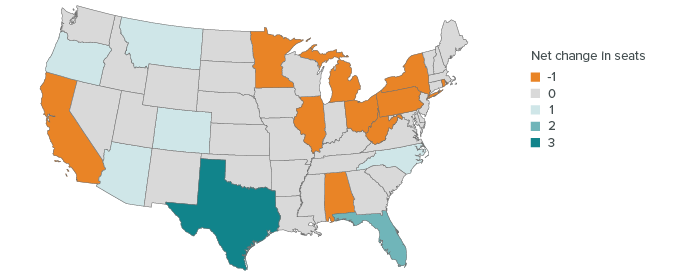
SOURCE: American Community Survey, US Census Bureau, 2012 and 2018.
NOTE: Population projections use the method described in McGhee, Bohn, and Thorman, The 2020 Census and Political Representation in California (PPIC, 2018).
Within the state, an undercount is likely to shift political representation away from some vulnerable communities. The San Joaquin Valley and Inland Empire are projected to have among the highest growth rates by 2020. But they are also at risk of an undercount. If these areas do experience an undercount, state and local representation could shift away from low-income communities of color in these regions and toward wealthier, whiter areas of the state.
The census also helps to determine the allocation of billions in federal funds going to the states. For California, this amounted to about $115 billion in federal funds in 2016 (the year of latest data available). The state relies on these funds for a broad array of programs such as Medi-Cal, food stamps/CalFresh, low-income housing vouchers, and children’s health insurance. These programs often serve the same populations that are hard to count. However, because federal programs use census data to allocate dollars in various ways, the impact of an inaccurate count varies by program. Medi-Cal funding, for example, would not be affected by an undercount.
Finally, the census provides an important benchmark for knowing basic facts about our country and how it is changing-where we live, whether populations are growing or declining, how much we are aging, and how diverse our population is. And census data influences government policy for years to come. When an undercount occurs, the repercussions are real: in 1990, the census missed 2.7 percent of California’s population, or about 835,000 people (a higher rate than the 1.6 percent it missed nationwide). This discrepancy likely cost the state a seat in the House along with more than $200 million in federal funds in a single fiscal year.
While subsequent counts have been much more accurate, the challenges facing the 2020 Census are considerable-and unique.
Census 2020 Has Been Surrounded by Controversy
Three overarching challenges have defined the run-up to Census 2020: funding, technology, and a protracted legal battle over the inclusion of a question about citizenship status.
The census is often described as the federal government’s largest peacetime mobilization effort, and the provision of adequate funding is a perennial concern. Most critically, funding determines whether the Census Bureau will have enough time and reach to prepare for the most accurate count possible. This time, inadequate funding was compounded by vacancies in key leadership roles in crucial early phases of census planning.
These stumbling blocks hindered efforts by the Census Bureau to test questions and new techniques-particularly online census forms. By the time Congress provided more funding, it was too late to fully perform those tests, leaving the bureau without enough time to uncover problems or make corrections. Although the bureau was able to make many improvements in the last year, the US Government Accountability Office considers Census 2020 to be a high-risk operation because it has only partially met several key implementation goals.
Funding is intimately tied to a new and unique challenge: bringing the census into the digital age. For the first time, a majority of American households will be asked to fill out census information online-a fundamental shift in how the census operates. This shift makes broader technology concerns-privacy, security, and access-a larger part of census operations in 2020.
In addition, a prolonged, rancorous public debate surrounded the Trump administration’s attempt to add a question about citizenship status to Census 2020. This addition was unanimously opposed by Census Bureau experts and it became embroiled in a lengthy legal battle with several states, including California. The Supreme Court eventually blocked the question in June 2019, but the debate served to heighten tensions around privacy and public trust. While majorities of Californians currently say they plan to participate in the census, noncitizens are less likely than citizens to say this (Figure 2).
Figure 2. Noncitizens are less likely than citizens to say they will participate in the census
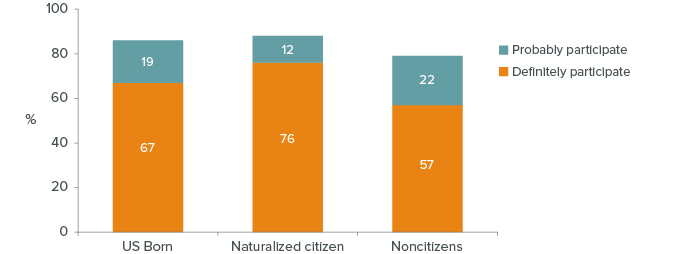
SOURCE: PPIC Statewide Survey, February 2020.
Taken together, these challenges are considerable-and their full effects will not be known for some time. However, they almost certainly motivated California to increase its own efforts to support an accurate count. From providing stepped-up funding to supporting widespread organizing efforts, the state has taken direct action to overcome its vulnerabilities in this decade’s census count.
California Will Be Hard to Count
California is the most populous state in the nation as well as one of the most diverse, home to the country’s largest number of immigrants. A substantial majority of residents-72 percent in the latest estimates-belong to at least one group that has historically been undercounted in the census. Hard-to-count communities exist in every part of the state, which means virtually every community must think about how to address the census to ensure an accurate count. But different parts of the state face different obstacles, and some places are especially hard to count.
The highest-profile undercount risk comes from immigrant residents. The census must count everyone, regardless of immigration status. California is home to almost 11 million immigrants, about 23 percent of them undocumented.2 These undocumented residents may perceive any contact with a government representative as raising the risk of deportation. The current political climate, including the battle over a citizenship question, has probably stoked those fears.
The census has historically undercounted African Americans, Latinos, and Native Americans of any citizenship status. Undercounts have varied in magnitude over the decades, and the bureau has made improvements since the especially poor 1990 count. But the 2010 census still undercounted African Americans by 2.1 percent and Latinos by 1.5 percent nationally. Native Americans and Native Alaskans living on reservations were undercounted by 4.9 percent. Together these undercounts translate to well over a million people across the country.
Young children are arguably the highest undercount risk. People with children younger than age 5 tend to be young themselves and have less understanding of and experience with the census. If someone other than a parent is responsible for filling out the census form, the odds of omitting a young child increase. Young children are also more likely to fall in other hard-to-count groups, increasing the likelihood that their entire family is missed (O-Hare et al. 2019). The problem has grown worse over time, and the 2010 census missed about 210,000 Californians ages 0-4, a 7.7 percent undercount rate that ranked third-highest in the nation.
Housing conditions play a fundamental role in the census count, because the census is household-based. Not only are rental units and mobile homes less likely to appear on official census address lists, but those who live in overcrowded or low-visibility conditions’such as garages, trailers, or basements-are also often missed. Displacements due to wildfires may also be a factor this year. And while Census 2020 has a plan for counting people who are living in homeless shelters or are unhoused, the challenge in California may be greater this time, given large increases in homelessness since the last census. The US Department of Housing and Urban Development estimates that California’s homeless population has increased 22.5 percent since 2010, behind only South Dakota and New York.3
Finally, the state’s digital divide may also impede an accurate count. In California, access to high-speed internet at home varies widely across counties-from more than 89 percent of homes with access in Santa Clara County to less than 70 percent in Trinity and Glenn Counties. Moreover, some households report having high-speed internet access only through a phone, which may affect low-income households even in areas with otherwise broad access to high-speed internet. Even though the census will not ask the lowest-access communities to respond online, and all households that do not respond online will receive a paper form, the effects of an online count are a critical unknown factor in Census 2020.
These undercount challenges hit some communities harder than others. Some parts of the state have many more people at risk of being missed than others, with most hard-to-count counties clustering in the central and southern parts of the state (Figures 3-5).
Figure 3. The San Joaquin Valley and Monterey County are expected to be among the hardest-to-count regions in California
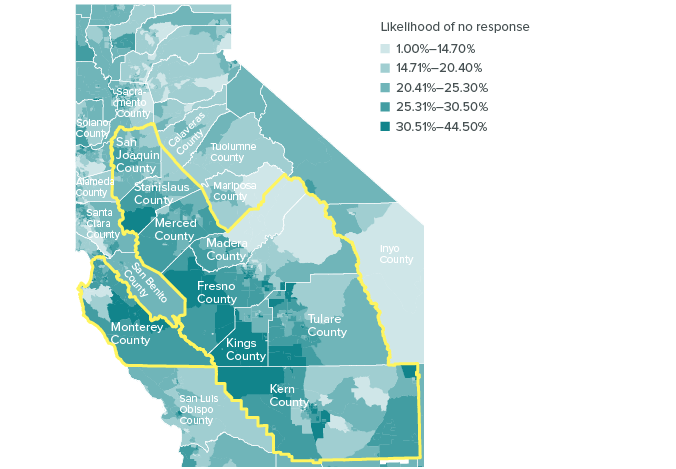
SOURCE: 2019 Census Bureau Planning Database.
NOTE: The map shows the share of households in each census tract that are unlikely to self-respond to census forms and may need follow-up in order to be counted accurately, according to Census Bureau estimates.
Figure 4. Densely populated Los Angeles County will be hard to count, especially central and east LA, but also throughout the valleys
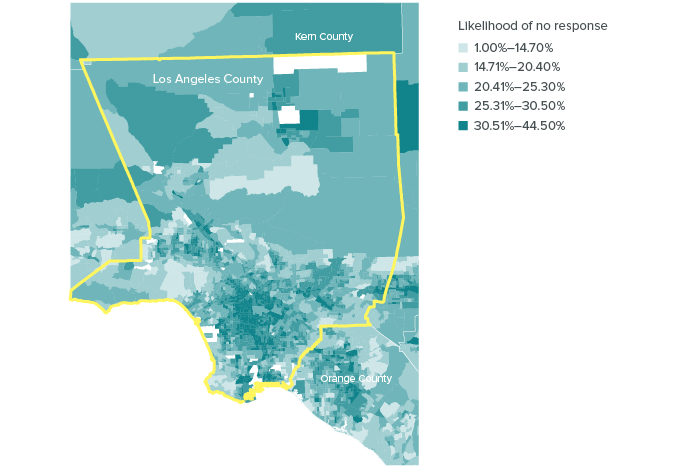
SOURCE: 2019 Census Bureau Planning Database.
NOTE: The map shows the share of households in each census tract that are unlikely to self-respond to census forms and may need follow-up in order to be counted accurately, according to Census Bureau estimates.
Figure 5. Sparsely populated Imperial County is likely to be very hard to count, especially the western half of the county
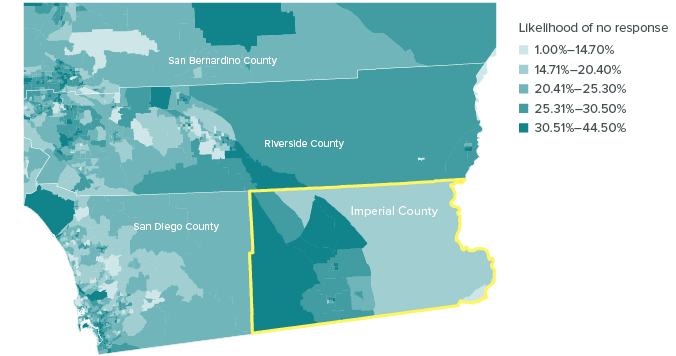
SOURCE: 2019 Census Bureau Planning Database.
NOTE: The map shows the share of households in each census tract that are unlikely to self-respond to census forms and may need follow-up in order to be counted accurately, according to Census Bureau estimates.
Some individuals are at higher risk as well. Many Californians fall into more than one of the above hard-to-count categories. For example, African American, Latino, and Native American children are much more likely than white children to live in overcrowded or low-visibility households, a challenge that may have gotten worse as California’s affordable housing grows scarce.
Finally, it is worth remembering that even regions with a lower likelihood of an undercount still have pockets of risk. The Bay Area overall has fewer hard-to-count communities than the areas mentioned above. Yet high housing costs there have led to many overcrowded or low-visibility households that will complicate the area’s count.
California Is Mobilized
California’s strong investment in Census 2020 is unprecedented-and far larger than any other state. Early concerns about an undercount motivated large contributions to state census preparation; since 2018, California has invested $187 million in census-related activities. These dollars are supporting planning and outreach across the state, with about half of the funds going to local governments and organizations working to ensure a complete count.
California’s outreach efforts started early and have ranged from investing in partnerships with tribal communities-one of the most undercounted populations-to developing a census curriculum for K-12 schools. Regional strategies to identify vulnerable areas and target resources accordingly have been key-for example, working with census ambassadors in San Diego to reach out in numerous languages, including Arabic, Kurdish, Farsi, Vietnamese, and Somali. The state is also planning to capitalize on strategies put forward by the Census Bureau, such as creating local partnerships to provide questionnaire assistance centers in libraries, community centers, places of worship, and other public places.
Along with contributing financially, the state’s nonprofit sector has provided much of the infrastructure for deploying state investments to local organizations and trusted messengers on the ground. This sector has also been instrumental in identifying effective messages that speak specifically to California’s diverse communities. For example, national and California-based research has shown that residents of Southern California and the Central Valley are more likely to participate when they receive assurances of confidentiality and when they learn more about what the census is for.4 The idea that participation in the census could improve children’s lives by increasing investments in schools and other public projects also proves compelling.
Will these efforts be enough to accurately count the country’s largest state? A good census count matters because a bad one will hamstring California for the next decade. The state’s population slowdown suggests that the loss of a House seat is possible even without an undercount. Our estimates suggest that California is quite close to the margin (within about 200,000 people) for keeping or losing its 53rd seat-putting further pressure on the necessity of an accurate count.
How will we know if the state has been badly undercounted? One possibility is to compare the census estimates with administrative records from the previous year, such as birth certificates or Medicare enrollment among seniors. These sources are relatively reliable and cover populations that are unlikely to have moved, making large deviations from the census numbers a possible sign of problems.
In this unusual census year, population tallies have already begun. By April 1, every household will be invited to respond to the census by mail, phone, or through an online form. The Census Bureau will follow up through the summer with those who have not responded, both by mail and, if needed, in person.
By the end of the year, apportionment counts for the House of Representatives will be delivered to the president, setting in motion redistricting efforts around the country. And California will be ready to move forward with a new understanding of its growing and changing population.
Topics
Health & Safety Net Political Landscape Population

